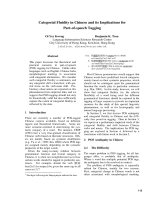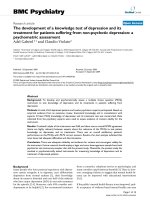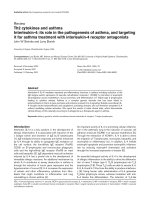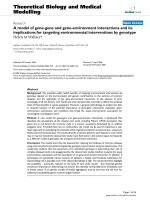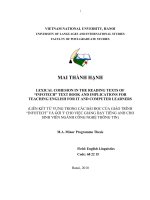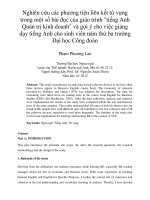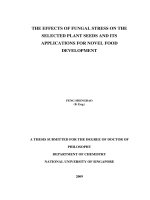THE ESSENCE OF COLLOCATION AND ITS IMPLICATIONS FOR TEACHING ENGLISH WRITING
Bạn đang xem bản rút gọn của tài liệu. Xem và tải ngay bản đầy đủ của tài liệu tại đây (70.51 KB, 11 trang )
VIETNAM NATIONAL UNIVERSITY, HANOI
UNIVERSITY OF LANGUAGES AND INTERNATIONAL STUDIES
POST GRADUATE DEPARTMENT
THE ESSENCE OF COLLOCATION AND ITS
IMPLICATIONS FOR TEACHING ENGLISH WRITING
SUBJECT: SEMANTICS
(Final Assignment)
Name: Dương Thị Tâm
Class: K18-English C
Lecturer: Dr. Hà Cẩm Tâm
Deadline of submission: 28th June 2010
HANOI–JUNE 2010
2
The Essence of Collocations and its Implications
for Teaching English Writing
Table of content
Page
PART 1: INTRODUCTION
2
1.1.
Rationale of the study
2
1.2.
Scope of the study
2
1.3.
Method of the study
2
1.4.
Research questions
2
PART 2: LITERATURE REVIEW
3
2.1.
Definitions of collocations
3
2.2.
Classification of collocations
2.3.
General characteristics of collocations
5
2.4.
Relationship between collocations and writing
6
3
PART 3: SOME IMPLICATIONS FOR TEACHING
ENGLISH WRITING
7
PART 4: CONCLUSION
9
REFERENCES
10
3
PART 1: INTRODUCTION
1.1.
Rationale of the study
Collocational deficiency is a common phenomenon in learner English.
Language learners often fail to choose the correct combination of two or more
words due to their unawareness of collocational properties. They are apt to adopt
lexical simplification strategies such as using a synonymous or mother tongue
influenced expressions. It is noticeable that most learners are not very good at
applying collocation in writing because they do not have full understanding of
collocation and its importance. Therefore, it is essential that we should have an
insight into the characteristics of collocations in order to use and apply it accurately
and properly in writing.
I would like to conduct a review to focus on the nature of collocations and its
implications for teaching English writing in the classroom.
1.2.
Scope of the study
This is a small study to concentrate on the nature of collocations and some
suggestions to teach writing in classroom.
1.3.
Method of the study
The study is carried out based on the following steps:
Seek, collect and
Analyze
Synthesize
Generate
select materials
documents
documents
conclusion/implication
s
1.4.
Research questions
I intend to conduct this study with two research questions bearing in minds:
4
1) What are collocations?
2) What are the suggestions of collocations could be proposed for English
writing teaching?
PART 2: LITERATURE REVIEW
2.1.
Definition of collocations
In fact, there seems to be no consensus as to the exact definition of
collocations which widely varied from one linguist to another depending on one’s
orientation and the paradigm he subscribed to. Nevertheless, one factor to these
definitions is the explicit statement of the relationship between one lexeme and
another and how they combine to form a collocation.
The term was first used by Firth (1951). To him, ‘collocation is the company
the words keep together’.
Leech gives out a more comprehensive definition of collocation. He presents
that collocative meaning consists of the association of a word acquire on account of
the meaning of words which tend to occur in its environment.
According to Benson, ‘In English as in other language there are may fixed,
identifiable, non-idiomatic phrases and constructions. Such groups of words are
called recurrent combinations, fixed combinations or collocations’. He illustrates
the examples of murder and its collocations: Commit, investigate, describe and
witness. It is immediately recognized that the verb ‘to commit’ is more closely
associated with murder than the three other verbs. To commit a murder is far more
fixed collocation than those with the other three verbs.
Jackson states that ‘collocation refers to the combination of words that have
a certain mutual expectancy. The combination is not a fixed expression but there is
a greater chance than the likelihood that the words will co-occur.’
In brief, as long as we are aware of what collocations are, we will be likely
5
to have better attention to how to use them properly in writing.
2.2.
Classification of collocations (based on the grammatical patterns)
Adj + N
e.g.
bright/ harsh/ intense/ strong light
gentle/ relaxing/ soothing massage
draft/ founding/ environmental charter
deep/ gaping/ huge chasm
Quantifier + N
e.g.
a beam/ ray of light
a chunk/ slice/ lump of cheese
a bar/ slab of chocolate
V+ N
e.g.
cast/ emit/ give/ provide/ shed light
join in/ sing chorus
smoke/ draw on/ pull on cigarettes
N+V
e.g.
light gleams/ glows/shines
banner flutters/ waves/ flies
N+ N
e.g.
a light source
bankruptcy order/ proceedings
Pre + N
e.g.
by the light of the moon
in a/ the bar
into the/ between/ with agreement
N + Pre
e.g.
the light from the window
6
battle against/ for/ between
V + Adv
e.g.
choose carefully
beam broadly/ positively/ happily
beg practically/ humbly/ silently
V+V
e.g.
be free to choose
V + Pre
e.g.
choose between two things
beg for/ from
blame for/ on
V + Adj
e.g.
make/ keep/ declare something safe
be/ seem/ consider sth blasphemous
be/ seem/ sound breezy
Adv + Adj
e.g.
perfectly/ not entirely/ environmentally safe
absolutely/ totally/ utterly brilliant
slightly/ rather/ uniformly brown
Adj + Pre
e.g.
Safe from attack
brown from/ over/ across your
* Notes: N: noun; V: verb; Adj: Adjective; Adv: Adverb; Pre: Preposition;
2.3.
General characteristics of collocations
Collocations can be described in a number of ways. One way of thinking
about them is in terms of "fixedness" - in other words, the degree to which you can
vary the basic pattern and still have a collocation. We can only define the fixedness
7
or unfixedness of collocations in terms of a continuum - all we can say is that some
are more fixed than others but we can't make a neat dividing line between "fixed"
and "unfixed".
A very fixed collocation is one in which the pattern has very few expected
variations. So, for example, the phrase "kick the bucket" is an idiom, a relatively
fixed collocation meaning "to die". While we could substitute nouns and verbs in
this sentence and get other meaningful sentences (e.g. "kick the door", "lift the
bucket"), the word combinations in these other sentences are no longer cohesive
patterns in the way that "kick the bucket" is. Like "kick the bucket", most
collocations which are very fixed form a particular expected meaning rather than a
structure.
Less fixed collocations are often more structural - common patterns that help
structure a sentence but don't carry as much specific meaning by themselves. For
example a less fixed collocation might be something like:
It's not important to be able to classify collocations according to their exact
degree of fixedness. However, it probably is helpful to know that some collocations
are more fixed than others: if you recognize a collocation as very fixed, you can
learn it as one item; if you recognize it as less fixed, you understand that there's a
pattern there that you can use to build a collection of useful related phrases.
In conclusion, it is also helpful to pay attention to how collocations relate to
the context around them. In some cases, especially with structures and longer
phrases, the use of a collocation depends very heavily on the situation in which it's
used. So for example, you probably shouldn't greet the president of the company
you work for by saying, "What's up?". On the other hand, other collocations, like
"get in a car" you can use almost anywhere.
2.4.
Relationship between collocations and writing
Collocations have only begun to receive substantial attention. In the field of
teaching writing, the need for more research on collocations is clear. More
8
importantly, the correlation between the use of lexical collocations and learners’ of
English writing fluency is far from completely understood. However, we might see
that a student equipped with good understanding of collocation and form the habit
of applying collocation into their writing will have stronger language competence.
PART 3: SOME IMPLICATIONS FOR ENGLISH
WRITING TEACHING
Needless to say, by mastering the rule of collocation and its close relationship
with writing, teachers should follow some main points to raise the students’
awareness to write up a better and more persuasive writing.
Firstly, acquisition of skills related to the correct use of collocations can be
hastened “as a result of explicit instruction or consciousness-raising” (Ellis, 1997).
Therefore, the most useful role for the teacher is to engage in consciousness-raising
in encouraging learners to notice the correct use of collocations. In other words,
consciousness of learners regarding the importance of collocations should be raised
during the process of acquiring the skills to use collocations.
Secondly, what non-English teachers need most in their classes is
appropriate workbooks that contain a selection of collocations geared to the specific
difficulties of learners with a particular mother tongue background. Such teaching
materials should allow the teachers to actually teach collocations, thus shortening
the long and laborious process of acquiring collocational competence through years
of studying, reading, and observing the language.
Thirdly, two factors regarding the characteristics of collocations should be
9
given more attention. One factor is the congruity and incongruity between the L1
and the L2. If teachers analyzed the incongruity between the languages, the teaching
and acquisition of collocations would likely be conducted more effectively. The
other factor is a restriction in the scope. That is, even though explaining the
combinations of collocations is very difficult, many conventional collocations must
be remembered in their original state.
Fourthly, the teaching of collocations should be considered equally
important as the teaching and understanding of verbs. The acquisition of L2 verbs is
a most perplexing problem because the meaning of L2 verbs does not necessarily
have an equivalent connotation as those in L1 according to their semantic context.
Finally, we should not learn collocations by intensive reading only;
extensive reading should also be given priority. Learners should be involved in
extensive reading of works of literature written in English, thereby exposing them
to a massive amount of vocabulary and new collocations priority. Learners should
be involved in extensive reading of works of literature written in English, thereby
exposing them to a massive amount of vocabulary and new collocations.
PART 4: CONCLUSION
Our brain tends to store language in chunks, rather than individual words.
Thus, when we speak or write, it is more efficient for us to remember and use
phrases as chunks rather than constructing them one word at a time. This increased
efficiency promotes fluency.
The two main research questions have been answered to some extents. We
see that when it comes to writing, students are expected to show their strong
10
language competence and one way to judge is by looking at their appropriate
application of collocations. Therefore, teachers should always highlight the key
features as well as the importance of collocation and put them in into practice to
build students’ the capacity of using collocation in writing.
REFERENCES
1. Benson, M., Bense, E. and Lisons, R. The B.B.I Combinatory of English,
Amterdams, Benjamin, 1986
2. Ellis, N. C. 1997. Vocabulary acquisition: Word structure, collocation, wordclass, and meaning. In: N. Schmitt & M. McCarthy, (Eds.), Vocabulary:
11
Description, acquisition and pedagogy. Cambridge: Cambridge University
Press.
3. Jackson, Howard, Words and their meanings, p.99, London, Longman, 1988
4. J.R. Firth, “Modes of meaning” in “Papers in Linguistics”, London, Oxford
University Press, 1951
5. Leech, Geoffrrey, Semantics, London, Penguin, 1974
6. Moira R. , Oxford Collocations Dictionary for students of English, Oxford
University Press, 2007

